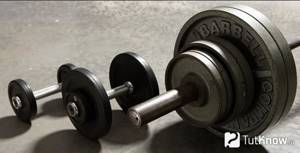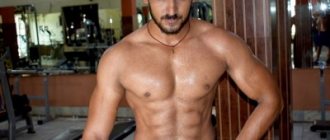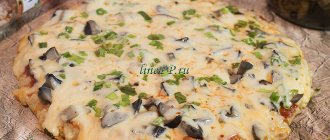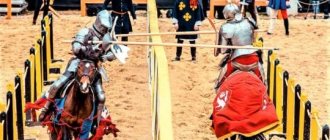Plus to karma
Pay attention to Michael Phelps's foot size. Yes, she's gigantic! Of course, a four-meter arm span along with a 47-foot leg size gives the swimmer additional speed. Or look at how Usain Bolt's body works. It's like it's designed to run as fast as possible. Now imagine the fastest man on Earth, but with short, undeveloped legs. In this case, Bolt could only dream of world records.
There are different concepts of human predisposition. Nasser El Sonbati said that genetics is the body’s ability to process a huge number of different potent drugs without harming health. But he died at the age of 47. Apparently, his body could not cope with such a volume of chemistry.
There is no doubt that Ronnie Coleman, Jay Cutler, Phil Heath, Dorian Yates are genetically unique athletes, of whom there are only a few in the world. But they, of course, are the stars of professional bodybuilding, where goals are achieved by any means necessary.
Bodybuilding and genetics. How do I know if I have good genetics for bodybuilding?
Posted by John Hansen |
How do I know if I have good genetics for bodybuilding? I just started working out and I can't even imagine that I could look like these guys in the magazines. Maybe I'm wasting my time?
It is usually very difficult to determine a person's genetic potential at the very beginning of training. There are some aspects that bodybuilders have no idea about at all. You may have great genetics, but never realize them.
The first aspect is bone structure. The ideal bodybuilding option is broad shoulders and a narrow waist - what made Sergio Olivia and Steve Reeves famous. A wide chest is also desirable. Can you imagine Arnold in his impressive side chest pose without his huge chest?
Bone structure matters. A heavy, thick bone structure can be a great advantage in sports such as football, rugby and powerlifting, but for a competitive bodybuilder it will compromise symmetry. On the other hand, thin bone can limit the amount of muscle mass you can gain and the weights you can lift in training.
The length of individual bones determines your physique. Some bodybuilders, like Lee Haney and Ronnie Coleman, have short torsos and long legs. Others, like Nasser El Sonbaty and Mike Matarazzo, have long torsos and short legs. Legs or torso that are too short can disrupt overall symmetry.
After taking into account the structure of your body, you need to pay attention to the muscles themselves. The shape of individual muscle groups is genetically determined and can only be improved, but not changed. Compare Mr. Olympia Chris Dickerson's round pectoral muscles with Steve Reeves's lats and rectangular muscles. Look at Larry Scott's long, thick biceps and compare them to Albert Beckles' short, peaked biceps. They all inherited this muscle shape, and did not get it through training.
In addition to the shape of the muscles, muscle cells are also important. We inherit a certain amount of them in each muscle group. You've probably noticed that some people have huge, superbly shaped calf muscles without really training them. They were lucky enough to inherit them.
In most cases, even world-class bodybuilders have some parts of their body that are simply outstanding and others that are clearly weak. All this is mainly due to the number of muscle cells in them. Mr. Universe Kal Szkalak had a torso comparable to Arnold's, but couldn't develop his lower body to match. Franco Columbu couldn't get his arms to match his gorgeous torso. Gary Strydom's latissimus dorsi muscles were no match for his pecs, deltoids, and arms. Even among professionals, few people have ideal proportions.
We must not forget about the type of muscle fiber. Fast-twitch fibers are used during activities that require speed and strength, while slow-twitch fibers are used during slow, sustained activities that require endurance. Usually a person has an equal amount of these fibers. Obviously, world-class sprinters have more fast-twitch fibers, while marathon runners have more slow-twitch fibers. It was their genetic data that allowed them to climb onto the victory podium in their sports.
It is likely that high-level bodybuilders have more fast-twitch fibers than slow-twitch fibers. They are responsible for the growth of strength and mass, their dominance determines your abilities in this regard. With a predominance of slow-twitch fibers, it will be more difficult for you to gain weight.
Another factor is metabolism. For some bodybuilders it is very fast (ectomorphs), it is almost impossible for them to significantly gain muscle mass and body weight. Those with a very slow metabolism cannot gain lean muscle mass without a significant amount of fat. Both of these extremes create difficulties for bodybuilders.
As I already said, at the very beginning of training it is almost impossible to accurately determine your genetic potential. Among the superstars of bodybuilding there are many who, it would seem, had no potential at all before joining bodybuilding. Lou Ferrigno, as noted in the movie Pumping Iron, was so skinny that he wasn't picked for his high school football team. Samir Bannout was also skinny when he first joined the gym, his knees were thicker than his thighs. Franco Colombo, Frank Zane are all Mr. Olympia title holders, but they wouldn't even have won the Mr. Quarter title when they first started training.
Some bodybuilders grow very quickly, but due to their bone structure they will never rise to the rank of professionals. Tim Belknap, Mr. America '81, gained weight quickly and built a physique that was ahead of its time, but this was in the days when size and muscularity were prized. When he reached the professional level, judges ignored him in competitions, and he soon retired from the sport. Tim was too massive, heavy and boxy, his shoulders and torso not shaped like a cone.
Ronnie Coleman, on the other hand, has always had excellent bone structure. But when he entered the professional stage, the judges also did not notice him because he was not big enough. As a result, he came last at the 1992 Mr. Olympia. As Ronnie grew bigger and bigger, he climbed the steps of the Olympia higher and higher. But without his outstanding bone structure, he would never have dominated the sport.
You may have a metabolic type and other genetic makeup that will outweigh your lack of ability to gain weight quickly. Arnold won Mr. Universe at the age of 20, just five years after starting training, and then became the youngest Mr. Olympia three years later. But Frank Zane took his first Olympia at the age of 35 - after more than 20 years of training. He did not have the genetic predisposition to quickly gain size and strength, but by developing his form and symmetry, after many years of hard work and strict nutrition, he was able to achieve the highest title in our sport.
Are you wasting your time? You must honestly evaluate your physical potential and ask yourself if you are willing to put in the hard work, the discipline, and the persistence you need to realize your genetic potential. There have been many bodybuilders with great abilities who have been beaten by people who are much less gifted but more persistent, thoughtful and aggressive.
My advice is unlikely to help until you decide what you want from your body. When I started training as a skinny 14-year-old, I weighed 61kg and no one would have said I had bodybuilding potential. I became the absolute champion only at the age of 23, it was a victory at “Mr. Illinois”. At the age of 29 I won the title “Natural Mr. Universe”, this was after 15 years of training! I knew for sure that I had a good structure, I just had to work hard to gain the mass that corresponded to this structure. From the very beginning I was sure that I would achieve the figure of Mr. Universe, I just had to convince my own body that I was right.
I've gained some good muscle mass, but my strength isn't increasing at the same rate, and I'm really upset about it. The gym is full of guys who are much stronger than me, and I don’t understand why. How can I become stronger?
First of all, don't be upset. Everyone's strength levels are different. This largely depends on the natural strength of the ligaments and tendons, as well as the lever properties of your bone structure. As you quite rightly noted, many very strong people do not look like strongmen at all.
Look at Mr. Olympia Franko Columbu. With a height of 165 cm and a weight of 84 kg, he was very strong. He could bench press more than 228 kg, did deadlifts with a weight of 320 kg for several repetitions, and in other exercises he also worked with bending weights. He was always stronger than Arnold when training in the gym, which explained why he was his favorite training partner. Arnold was well aware that he had to constantly pull behind Franco during hard training.
Despite this, Franco could never beat Arnold on the bodybuilding scene. Arnold's height and magnificent symmetry always overwhelmed him when they had to act as rivals. I trained with natural bodybuilder Tito Raymond three days before the competition and was amazed at his strength. He rep squatted 228 kg with a body weight of only 82 kg. But he is not a powerlifter, just a very strong bodybuilder.
I live in Chicago, where the strongest man in the world lives. Eddie Coan is stronger than any powerlifter on the planet. He usually competes in the 110 kg category and his total result in the three lifts is always the best. Eddie is very thick and stocky, but to look at him I would never have guessed that he could squat over 456kg!
In saying all this, I want you to understand the importance of developing strength to achieve your bodybuilding goals. Strong muscles usually have corresponding volume. If you develop your strength so that you can bench press 150 kg instead of the previous 120, then your chest, delts and arms will increase slightly in size due to the increased tonnage being lifted.
You should always aim to lift heavier weights in your workouts. Judge the amount of weight by the number of repetitions you do with it. If it's 12-15, then the weight is too light. You need to increase it to strengthen the ligaments and tendons. This is the key to developing strength.
Performing exercises with weights that allow you to do 6-10 repetitions is just what you need to gain mass. Strength will also increase, but the main thing is still mass. By lifting weights for 3-5 reps, you build ligaments and tendons. Here's the rep range you need to be in to gain strength. Now let’s talk about how to incorporate strength training into a regular bodybuilding program. Let's say you're doing a bench press. You start with a warm-up of 15 repetitions, then add weight with each set, decreasing the number of repetitions. A good progression should look something like this: 10, 8, and 6 reps. Just three sets. Now increase the weight further and try to do three good reps in two sets using a weight that you haven't even tried before. You don't have to do this every chest workout, but incorporating two heavy sets like these into your routine will gradually increase the strength of your ligaments and tendons.
Another method is forced repetitions. Although they are very intense and can lead to overtraining, they have significant benefits if done correctly. After warming up for a few sets, use a weight that you can only lift for two or three reps. Have a partner stand behind you while you do these reps on your own. When you can't move the weight anymore, let it help you do a couple more reps. By doing three reps on your own and two with a partner, you'll develop strength with a weight that you wouldn't even approach with the goal of doing 6-8 reps on your own. Forced reps are a good method for breaking through sticking points and stimulating new muscle growth.
Working with heavy weights and low reps can easily lead you to overtrain. Since the blood supply in ligaments and tendons is somewhat worse than in muscles, they need more time to recuperate. By constantly training hard, you can very easily overtrain the connective fibers before they are fully restored.
One way to avoid the problem is to cycle the total weight. This is exactly what powerlifters do when preparing for competition. They don't just go to the gym and lift as much as they can, hoping they can meet their target weight for competition. Instead, they have a well-designed training cycle in which they slowly increase resistance over 6-10 weeks.
Here is an example of a heavy circuit for the bench press. Always start your workout with two or three warm-up sets.
| Week 1: | 3 x 5 x 142.5 |
| Week 2: | 3 x 4 x 145 |
| Week 3: | 3 x 3 x 147.5 |
| Week 4: | 3 x 5 x 145 |
| Week 5: | 3 x 4 x 147.5 |
| Week 6: | 3 x 3 x 150 |
| Week 7: | 3 x 5 x 147.5 |
| Week 8: | 3 x 4 x 150 |
After eight weeks of this power cycle, I gave myself a week of rest to fully recover. Then, when I returned to my regular program, I felt much stronger. If at the beginning of the cycle I could bench press 142.5 kg six times, then at the end - 147.5-150 kg.
Note that the weights were increased very slowly, which gave me the opportunity to recover well.
If at the very beginning of the cycle I tried to immediately start with heavy weights, then, most likely, I would hit a dead point before the end of the cycle. In all three working sets, you should be working with weights that you can lift on your own without any assistance. All articles
Without fanaticism
But we just want to get in shape for the beach season, right? This means that we are interested in the usual increase in muscle mass and strength indicators, without fanaticism. But even in this case, not everything is so simple. You can be completely unpredisposed to bodybuilding. Let’s say, it will be more difficult for a tall person, about 200 centimeters, to achieve results in the gym. Long limbs and a huge femur increase the range of motion. There will be a result, but it will take much longer to achieve it.
Analysis and motivation
Good genetics give you a better chance of muscle growth and allow you to achieve your goals faster. But this does not mean that you can give up hard training in the gym. On the contrary, a positive disposition should motivate one to work even harder to see what limits can be achieved.
But what to do with bad genetics? Even if you are obese, you just need to make it a rule to exercise every day. If you are ambitious, if you are inclined to analyze failures, then you should not look for them in genetics. Rather, it is better to analyze your own natural data and create a proper training program. You may not win the world championship, but your own unique bodybuilding program will help you stand head and shoulders above the average unmotivated gym goer.
Bad genetics is not a reason to give up
Success in bodybuilding largely depends on what kind of genetics you have, if you are not so lucky with this matter, then of course you will need to go through many trials on the way to achieving the body of your dreams! Of course it's not very pleasant, but it's not the kind of thing that makes you quit bodybuilding. Understand that not all training methods work the same for all people, try different methods and then you may be able to overcome your bad genetics. Here are some tips to help you achieve your goals.

Secret of success
Bad genetics can also influence it. Persistence, willpower, determination, a serious attitude to business and proper nutrition are the components of success. There are many examples of people with poor genetics achieving outstanding results. These examples can be seen both in professional sports and at the amateur level. Few people know that the current Mr. Olympia Phil Heath in his youth was skinny and too narrow in the shoulders. No amount of medication could make his shoulders broad and round. Many years of work were done, thanks to which the American achieved spherical deltas.
Drop sets to overcome the genetic threshold

It is for this reason that cardio exercise, unlike strength training, cannot lead to weight gain. Aerobic exercise cannot create the required tissue tension to ensure hypertrophy. But not only mechanical tension leads to the growth of muscle fibers. One such factor is metabolic stress. To put it simply, this is the process of accumulation of various metabolites in the muscles, for example, lactate or hydrogen ions. They lead to a decrease in acidity levels. Today, scientists cannot yet name with complete confidence all the mechanisms of this process, but it is absolutely established that weight gain is affected by cell swelling, myocyte injury, and an increase in the concentration of anabolic hormones.
In theory, the combination of high strength loads and metabolic stress creates ideal conditions for muscle growth in muscle tissue. You can increase metabolic stress by increasing the rate of anaerobic glycolysis. During this process, a large number of metabolites are created. It should also be said that during strength training, blood vessels are compressed, which also increases metabolic stress.
Everything we just talked about can be achieved through drop sets. The essence of this method is to perform a large number of fatiguing repetitions with a large working weight. After this, you need to reduce the load and perform a couple more repetitions.
Thus, you need to perform the exercise to failure, then reduce the weight of the projectile by 20 percent and perform as many repetitions as you can. Then, if you still have some strength left, you can continue to reduce weight and do the exercise.
This method is very effective, but it is important to remember that it poses a certain danger to the process of nervous regulation of the muscles being trained. You need to use it correctly and not get carried away, otherwise you will simply overtrain.








